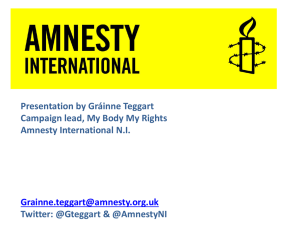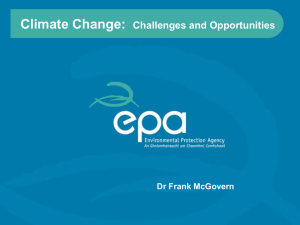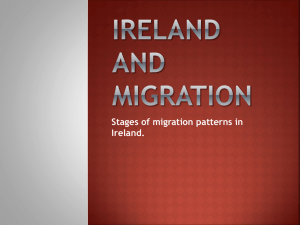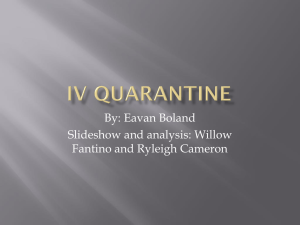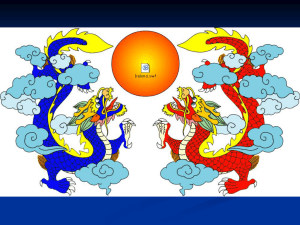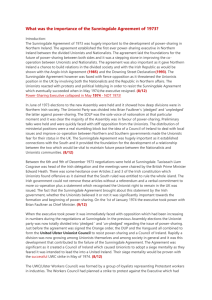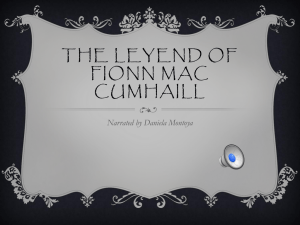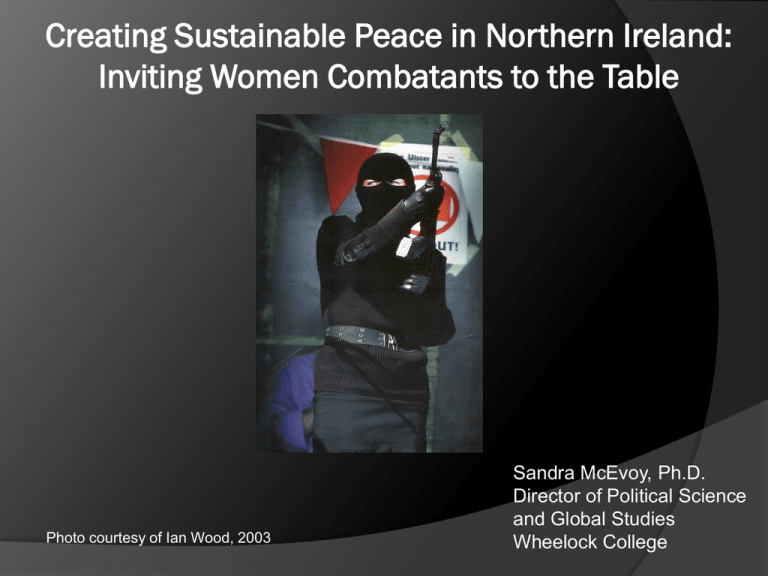
Creating Sustainable Peace in Northern Ireland:
Inviting Women Combatants to the Table
Photo courtesy of Ian Wood, 2003
Sandra McEvoy, Ph.D.
Director of Political Science
and Global Studies
Wheelock College
Outlining a pathway from violence
to the peace table
1.
History and key actors to the conflict in Northern
Ireland.
2.
Reframe the security debate to take a more thoughtful
look at the threat that women combatants already pose
to sustainable peace.
3.
Reflect on the insights of women members of
Protestant paramilitary groups in Northern Ireland
between 1974 and 2007.
4.
Solidify the connection between the threat and promise
of bringing combatant women to the peace table.
Roots of the
Northern Irish Conflict
1170 Norman
Invasion of Ireland
1916 Easter
Uprising
1920 Government
of Ireland Act
1966
Republicans/Nationalists
“celebrate 50 years of
struggle” against the
British
“1968 – 1998
“The Troubles”
Language of Conflict
Loyalist
○ Considered “extreme” portion of Protestant/Unionist population
willing to use violence.
○ “Loyal” to the British crown
○ Main groups: Ulster Defense Association (UDA) and Ulster
Volunteer Force (UVF).
Republican
○ Considered “extreme” portion of Roman Catholic/Nationalist
population willing to use violence.
○ Main groups: Irish Republican Army (IRA) and Provisional IRA .
Paramilitaries
○ Members are civilian or non-state actors
○ Groups adopt military organizational structure
○ Loyalist paramilitary organizations (LPOs)
Gendering
Peace and Security
“Analysis of women’s uses of politicized
violence in global politics is needed if
women’s experiences of war and conflict is
to be understood beyond their status as
victims” (Sjoberg and Gentry 2007).
Stereotypes of women as
“threats” to peace and security
Non
- thinking
Easily manipulated
Overly emotional
Unnatural
Sex crazed
Commonality - stripped of agency
Feminist-informed investigations by academic
and activist researchers have revealed that
many forms of public power and private power
are dependent for their operation, legitimation
and perpetuation upon…controlling popular
notions of femininity and masculinity… if we do
not become seriously interested in the
conditions and lives of women, we are likely to
craft analyses of international power dynamics
that are at best incomplete, at worst faulty and
unreliable.
Enloe 2007
Participants
30 women who
identified as past or
present members of
LPOs
Ages 22 – 64
Married, divorced and
very few single
All self-identified as
working-class
Rural and urban
women
Mothers, grandmothers
and those without
children
Highest levels of
education - middle
school (age 13) to high
school (age 18)
Interviews took place in
the women’s homes or
other safe place selected
by them
Themes in interviews
1. Rejection of the stereotype that as a group,
Protestants live among the comfortable middleclass.
2. Misconception that Loyalist women did not
participate in LPOs or have an interest in
participating in peace negotiations.
3. Anger and frustration with the British
government’s cross-border negotiations with
Republicans.
Cross-border Initiatives and
“Disagreements”
•
1974 - 2007 the British and Irish governments engaged in 4 separate
attempts to bring political stability and reduce armed conflict in Northern
Ireland.
•
Initiatives aimed to devolve power, create a power sharing executive and
reform social and political structures.
•
“Disagreements” - unacceptable compromises that Loyalists thought
only rewarded Republicans for violence against the British state.
•
In 30+ years of research on the conflict, scholars and political party
leaders have either excluded LPO women from their thinking or have
assumed that their views mirrored that of their male counterparts.
Cross-Border Initiatives
Sunningdale
Anglo-Irish
Good
– 1974
- 1985
Friday (GFA) / Belfast Agreement –
1998
St. Andrews Agreement
– 2007
Lincoln Courts, 2004.
Londonderry, Photo courtesy of
Jonathan McCormick
Ballysillan Road, Belfast ,
2006. Photo courtesy of
Jonathan McCormick
Sunningdale - 1974
Respondent:
That was the time whenever
they tried to force that other
agreement, not the AngloIrish one...the…the…
Interviewer:
Sunningdale?
Respondent:
Yes, because that was the
reason why I got involved.
“Gloria.” Interview with author. Belfast June 2006.
Sunningdale Agreement
As I say, because we felt at risk, you know? We
felt hard done by. You could see your whole
culture and your whole way of life just going down
the drain and becoming a united Ireland. You
know? You could just see that. You can see that
to this very day we are all still very, very frustrated.
You could see that then you can still see it.
“Chloe,” interview with author, Belfast, June 2006
Responding to Sunningdale
•
Chloe repeatedly states her fear of her Protestant culture being
degraded by further advances by Republicans . She saw
Sunningdale was just the start of a “United Ireland.”
•
Her concerns about the formation of a “United Ireland” was as
present for her in July 2006 as it was in December 1974.
•
In almost a refrain, she states, “You could just see that. You could
see that then and you can still see it…” and, “You can see that to
this very day” suggesting that she feels as though the threat of a
United Ireland remains.
Reflecting on Good Friday
…[people] like me, they didn't understand all
the implications. I knew the police force was
going to get a good shake up. But I didn't
realize how much and that we would lose
the RUC all together… After thirty years we
had had enough… but we didn't realize the
price we would have to pay.
“Chloe” Interview with the author,
Belfast 2006
Loyalist Opposition to the GFA
Photo courtesy of Jonathan
McCormick, 2006
Locating women in the dialogue
on conflict and post-conflict
Conflict as a factor in
“reshaping” women’s lives
1. sudden accession to household head with
limited resources
2. mobilized as soldiers in patriarchal militaries
3. subjected to increased medical and social
vulnerability
4. shoulder increased security risks in
disintegrating polities
Karam, 2001
Conflict as a factor in
“reshaping” women’s lives
5. confront increased sexualized violence
6. negotiate family disruptions
7. disadvantaged refugees
8. experienced increased violence in
‘domestic’ space
9. engage war structured sexual work
Karam, 2001
Women in the “post-conflict” period
UNSCR 1325 (2000)
Calls on Members States to consider the special
needs of women and girls at all levels of
repatriation, resettlement, reintegration and postconflict reconstruction processes.
UNSCR 2212 (2013)
Calls on Member States to fund women’s
leadership programs and local civil society
organizations who disproportionately do the difficult
daily work of conflict prevention and resolution.
DDR in Northern Ireland
Northern Ireland has never seen a formal DDR process and
has never had a UN presence.
The focus was on decommissioning of weapons and
demilitarizing the country at the expense of all other areas
of focus.
Not surprisingly these processes have excluded combatant
women (as they often do in many post-conflict environments).
Further complicating recovery - many women do not want it
known that they were involved in politically violent groups for
fear that they will be stigmatized or ostracized by their
families.
DDR’s “mixed bag” in Northern
Ireland
In Northern Ireland, LPO women “self-demobilized.” This
process allowed many women to return to the status quo
immediately after the conflict ended.
However, other women expressed a sense of frustration
that the end to the conflict would also bring an end to a
type of emancipatory politics that was impossible in
traditional Protestant communities.
The combination of the denial of women’s role and the
race to normalcy following the conflict meant LPO women
were by definition excluded from peace processes.
Impacts of excluding LPO
women from conflict
resolution processes
Making the link – combatant women
and sustainable peace
1. Combatant women are a violent constituency capable
of disrupting the success of any negotiated peace.
2. Combatant women have important insights and
interests that are useful to negotiations.
3. Inclusion of combatant women interrupts gendered
stereotypes of women as necessarily peaceful,
lacking agency and interest in peace possibility
increasing the likelihood of resolution.
Concluding Thoughts
Inclusion of women combatants in conflict resolution processes
is untested but the potential benefits are promising.
Inclusion of politically violent women in such negotiations is not
a panacea.
The testimony of LPO women has exposed a fatal error of
British negotiators that there is a gendered dimension to peace
and security.
Interviews with women members of LPOs reveals what scholars
have previously been hesitant to acknowledge: where women
stand on the multiple and complex issues surrounding political
conflict has an impact on security and peace.

